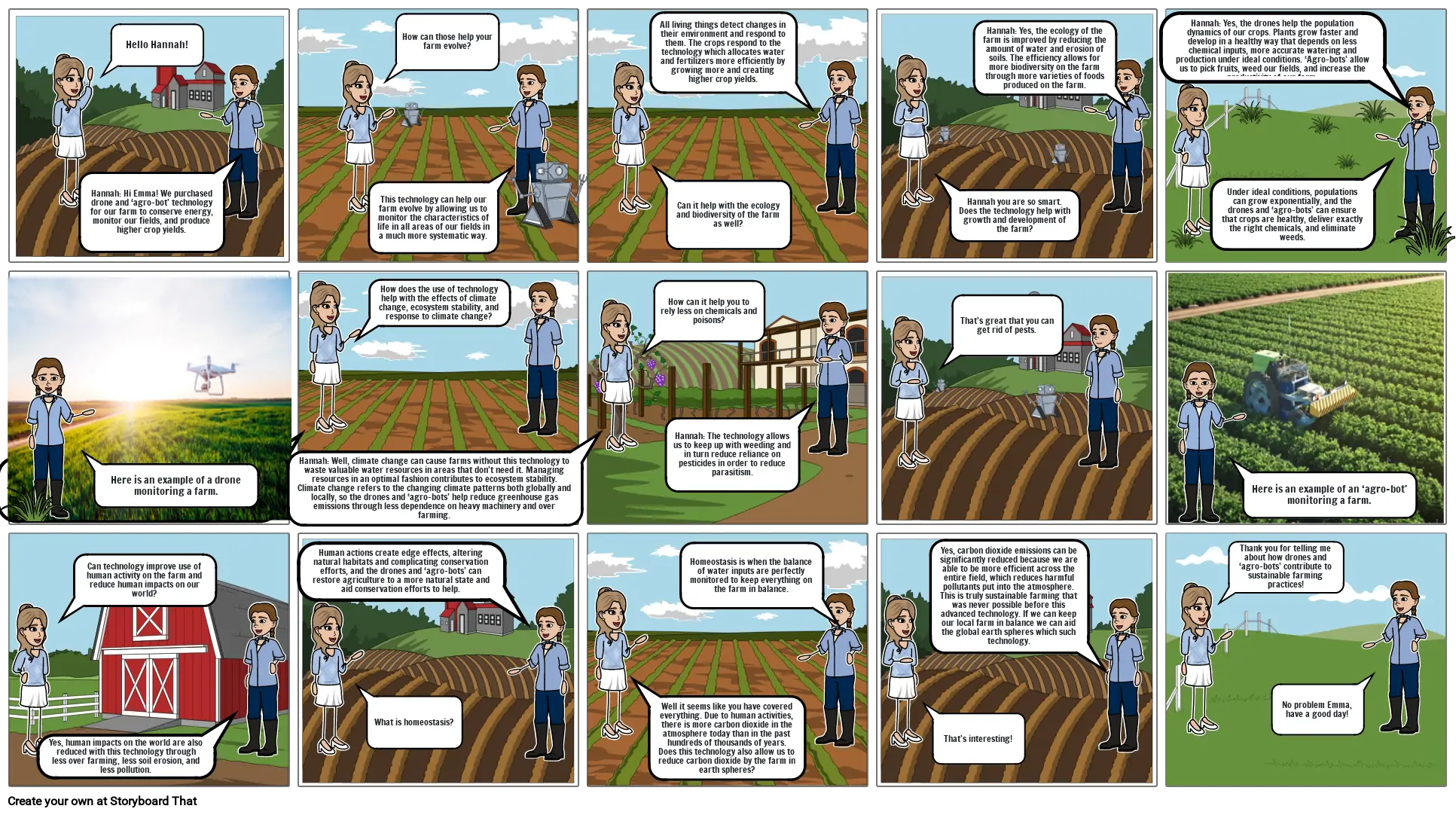Drones and ‘agro-bots’

Storyboard Tekst
- Hannah: Hi Emma! We purchased drone and ‘agro-bot’ technology for our farm to conserve energy, monitor our fields, and produce higher crop yields.
- Hello Hannah!
- This technology can help our farm evolve by allowing us to monitor the characteristics of life in all areas of our fields in a much more systematic way.
- How can those help your farm evolve?
- All living things detect changes in their environment and respond to them. The crops respond to the technology which allocates water and fertilizers more efficiently by growing more and creating higher crop yields.
- Can it help with the ecology and biodiversity of the farm as well?
- Hannah you are so smart. Does the technology help with growth and development of the farm?
- Hannah: Yes, the ecology of the farm is improved by reducing the amount of water and erosion of soils. The efficiency allows for more biodiversity on the farm through more varieties of foods produced on the farm.
- Hannah: Yes, the drones help the population dynamics of our crops. Plants grow faster and develop in a healthy way that depends on less chemical inputs, more accurate watering and production under ideal conditions. ‘Agro-bots’ allow us to pick fruits, weed our fields, and increase the productivity of our farm.
- Under ideal conditions, populations can grow exponentially, and the drones and ‘agro-bots’ can ensure that crops are healthy, deliver exactly the right chemicals, and eliminate weeds.
- The drones and ‘agro-bots’ promote sustainable agriculture through optimized resource usage and eco-friendly practices. The technology allows us to keep up with weeding and in turn reduce reliance on pesticides in order to reduce parasitism. Also, when sprays are needed, we can be much more targeted and not overuse chemicals.
- Here is an example of a drone monitoring a farm.
- Hannah: Well, climate change can cause farms without this technology to waste valuable water resources in areas that don’t need it. Managing resources in an optimal fashion contributes to ecosystem stability. Climate change refers to the changing climate patterns both globally and locally, so the drones and ‘agro-bots’ help reduce greenhouse gas emissions through less dependence on heavy machinery and over farming.
- How does the use of technology help with the effects of climate change, ecosystem stability, and response to climate change?
- How can it help you to rely less on chemicals and poisons?
- Hannah: The technology allows us to keep up with weeding and in turn reduce reliance on pesticides in order to reduce parasitism.
- That’s great that you can get rid of pests.
- Here is an example of an ‘agro-bot’ monitoring a farm.
- Yes, human impacts on the world are also reduced with this technology through less over farming, less soil erosion, and less pollution.
- Can technology improve use of human activity on the farm and reduce human impacts on our world?
- Human actions create edge effects, altering natural habitats and complicating conservation efforts, and the drones and ‘agro-bots’ can restore agriculture to a more natural state and aid conservation efforts to help.
- What is homeostasis?
- Well it seems like you have covered everything. Due to human activities, there is more carbon dioxide in the atmosphere today than in the past hundreds of thousands of years. Does this technology also allow us to reduce carbon dioxide by the farm in earth spheres?
- Homeostasis is when the balance of water inputs are perfectly monitored to keep everything on the farm in balance.
- That’s interesting!
- Yes, carbon dioxide emissions can be significantly reduced because we are able to be more efficient across the entire field, which reduces harmful pollutants put into the atmosphere. This is truly sustainable farming that was never possible before this advanced technology. If we can keep our local farm in balance we can aid the global earth spheres which such technology.
- Thank you for telling me about how drones and ‘agro-bots’ contribute to sustainable farming practices!
- No problem Emma, have a good day!
Izrađeno više od 30 milijuna scenarija

